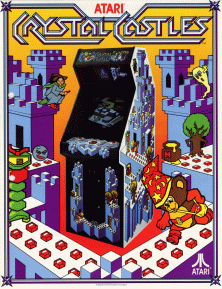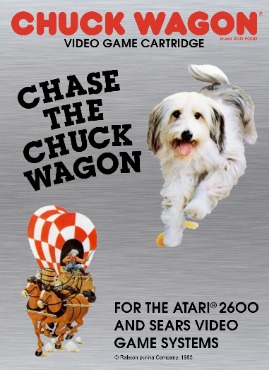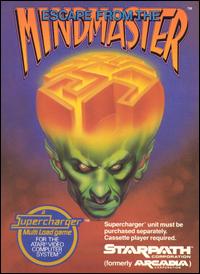Gameplay
The player's goal is to solve a maze consisting of a series of hallways and rooms. The rooms either are empty, contain puzzle pegs, or have a bonus game that allows the user to collect more points. Each level has its own individual bonus game. [2]
To solve the maze, players have to collect keys called "puzzle pegs" [3] that are designed as shapes to find their corresponding sockets. Only one peg can be held on to one at a time. [4] After placing all the pegs correctly, the player is able to go on to the next level through a now unlocked door. As the levels advance, the pegs begin to appear more similar to confuse the player. The pegs are placed randomly each time the game is re-booted. There is a time limit in which to finish the maze. Although players are not penalized for exceeding the time, they receive bonus points for each second under the time.
This must be done all the while avoiding the Alien stalker which roams the maze. If it gets too close to the player character, the player has to start again. There are two parts to each maze, a safe part, and the part where the creature is, separated by doors. The creature's proximity is indicated is by the beeping he makes. The louder and faster, the closer it is. In the more advanced mazes, there are also large squares that slide out of a wall into the adjacent wall which must be avoided in order for the player to progress. The third maze introduces one-way doors, which disappear once the player character goes through them.
Starpath was a U.S. company known for creating the Starpath Supercharger in August 1982. The company was founded under the name Arcadia Corporation in 1981 by Alan Bayley, Robert Brown, and Craig Nelson. It changed its name to Starpath shortly after for trademark reasons because Emerson Radio Corporation had released a video game console named the Emerson Arcadia 2001.

The Starpath Supercharger is an expansion peripheral cartridge created by Starpath, for playing cassette-based proprietary games on the Atari 2600 video game console.

Adventure is a video game developed by Warren Robinett for the Atari Video Computer System and released in 1980 by Atari, Inc. The player controls a square avatar whose quest is to explore an open-ended environment to find a magical chalice and return it to the golden castle. The game world is populated by roaming enemies: three dragons that can eat the avatar and a bat that randomly steals and hides items around the game world. Adventure introduced new elements to console games, including enemies that continue to move when offscreen.

Mouse Trap is a maze video game developed by Exidy and released in arcades in 1981. It is similar to Pac-Man, with the main character replaced by a mouse, the dots with cheese, the ghosts with cats, and the energizers with bones. After collecting a bone, pressing a button turns the mouse into a dog for a brief period of time. Color-coded doors in the maze can be toggled by pressing a button of the same color. A hawk periodically flies across the maze, unrestricted by walls.

Jr. Pac-Man is an arcade video game developed by General Computer Corporation and released by Bally Midway on August 13, 1983. It has the same gameplay as prior entries in the series, but the maze in Jr. Pac-Man scrolls horizontally and has no escape tunnels. The bonus item which moves around the maze changes dots into a form which slows Jr. Pac-Man as they are being eaten.

Crystal Castles is an arcade video game released by Atari, Inc. in 1983. The player controls Bentley Bear who has to collect gems located throughout trimetric-projected rendered castles while avoiding enemies, some of whom are after the gems as well.

Dragonstomper is a video game developed by Stephen Landrum for the Atari Video Computer System and released by Starpath. The game follows the adventures of a dragon hunter who is given a quest by the king to defeat a dragon and reclaim a magical amulet that was stolen. The player makes their way over the countryside, vanquishing various adversaries and gaining gold and experience. After achieving enough strength, the player can enter a shop in an oppressed village where equipment can be purchased, soldiers hired, and special scrolls obtained to defeat the dragon in its lair.

Communist Mutants from Space is a fixed shooter video game programmed by Stephen H. Landrum for the Atari 2600 with the Starpath Supercharger cassette accessory. It was published in 1982 by Starpath. The game is similar to Galaxian, adding a variety of gameplay-changing options.

Montezuma's Revenge is a platform game for the Atari 8-bit computers, Atari 2600, Atari 5200, Apple II, ColecoVision, Commodore 64, IBM PC, and ZX Spectrum. It was designed and programmed by Robert Jaeger and published by Parker Brothers in 1984. The game's title references a colloquial expression for diarrhea contracted while visiting Mexico.

Summer Games is a sports video game developed and published by Epyx based on sports from the Summer Olympic Games. Released in 1984 for the Commodore 64, it was ported to the Apple II, Atari 2600, Atari 7800, Atari 8-bit computers, and Master System.

Chase the Chuck Wagon is a 1983 promotional video game written by Mike Schwartz for the Atari 2600 and distributed by Purina. It was available only via mail order by sending in proofs of purchase to Purina. In the 1970s and 1980s, popular television commercials for Purina dog food included a dog chasing a tiny chuckwagon. The gameplay is loosely based on this premise.

Space Dungeon is a multidirectional shooter released as an arcade video game by Taito in 1981. Designed and programmed by Rex Battenberg, it was available both as a conversion kit and full arcade cabinet. An Atari 5200 port was published in 1983.

Wizard of Wor is an arcade video game released in 1981 by Midway. Up to two players fight together in a series of monster-infested mazes, clearing each maze by shooting the creatures. The game was ported to the Atari 8-bit computers, Commodore 64, Atari 2600, and Atari 5200 and renamed to The Incredible Wizard for the Bally Astrocade. The original cartridge came with a cash prize offer to the first person to complete the game.

Lock 'n' Chase (ロック・ン・チェイス) is a maze chase video game developed by Data East and released in arcades in Japan in 1981. It was licensed to Taito for distribution in North America. It has similarities to Pac-Man, including a goal of collecting dots, with the addition of doors that periodically block pathways. Home versions for the Intellivision and Atari 2600 were published by Mattel in 1982 and an Apple II version appeared in January 1983.

Tutankham is a 1982 arcade video game developed and released by Konami and released by Stern in North America. Named after the Egyptian pharaoh Tutankhamun, the game combines a maze shoot 'em up with light puzzle-solving elements. It debuted at the European ATE and IMA amusement shows in January 1982, before releasing worldwide in Summer 1982. The game was a critical and commercial success and was ported to home systems by Parker Brothers.

Several video games and genres have been created as a result of the release of the film E.T. the Extra-Terrestrial based on the story and themes of the original game.

Tunnel Runner is a first person maze game released by CBS Electronics in 1983 for the Atari 2600. It was programmed by Richard K. Balaska Jr. Tunnel Runner is one of three CBS games for the Atari 2600 with an additional 256 bytes of RAM in each cartridge, a feature promoted by CBS as "RAM Plus." The other two RAM Plus games are Mountain King and the port of Omega Race.

Oystron is an action game developed for the Atari 2600 by Piero Cavina and released in 1997. It is one of the earliest hobbyist-written games for the console. The game, Cavina's first, was initially made available as a freeware 4 KB binary file designed for use on the Starpath Supercharger and with Atari 2600 emulators. It was later released in cartridge form by XYPE, a group of Atari 2600 homebrew developers.

Sword of Saros is an action-adventure game for the Atari 2600 equipped with the Starpath Supercharger peripheral. The game was only sold via mail order by Starpath and few copies were made. It was programmed by Jon Leupp and Stephen Landrum.

Fireball is a Breakout clone video game developed by Arcadia for the Atari 2600. The game was released on cassette tape and required the Starpath Supercharger add-on to play.



















